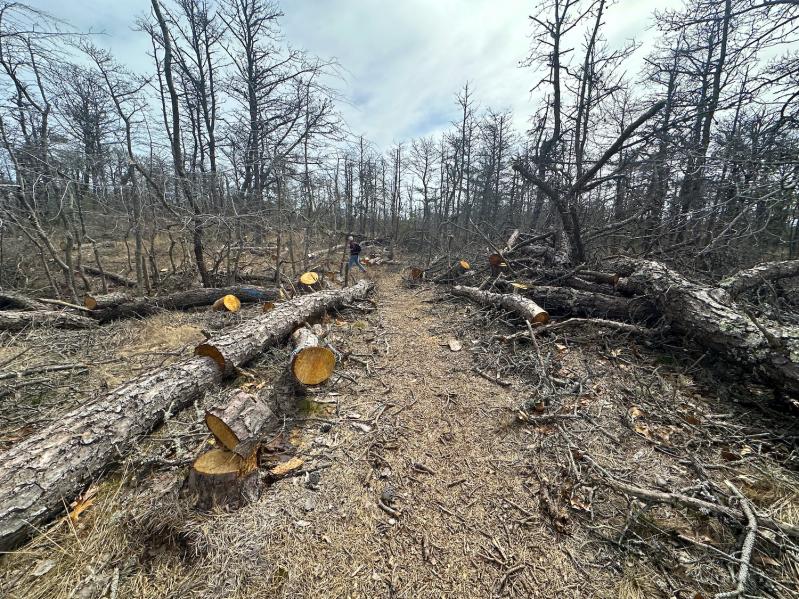LTV has launched the Pine Protection Project, an effort to address the southern pine beetle’s devastating impact on East Hampton Town’s pitch pine forests. The project is a multifaceted approach with a goal of fostering discussion leading to action and solutions, and will include a June 11 panel discussion at LTV Studios in Wainscott.
Native to the Southeastern United States, the southern pine beetle has expanded its range northward and was first detected in Suffolk County in October 2014. In East Hampton Town, where the invasive species was discovered in the autumn of 2021, vast swaths of dead pine trees are visible along the Napeague stretch and on Route 114 as well as in Napeague and Hither Hills State Parks. Many residential property owners have also been impacted by the beetles’ infestation.
The species’ northward spread is a manifestation of climate change, a New York State Parks, Recreation, and Historic Preservation official said during a February public meeting at Montauk Downs State Park. There, plans were outlined to reduce and mitigate threats to public safety, such as wildfires, along with strategies to protect and promote rare and vulnerable species and strengthen ecosystem resilience to pests and disease.
The southern pine beetle “crashed over our parks like a tidal wave in this area,” the Parks Department’s deputy commissioner of environmental stewardship said at that meeting. An estimated 40,000 trees were killed within a couple of years, the department’s forest health specialist added. State Department of Environmental Conservation-led efforts to squelch the spread of the invasive species proved unsuccessful.
The State Department of Transportation began cutting trees along Montauk Highway in 2023, and the Parks Department established 25-foot-wide fuel breaks where the pine forest meets residential areas. Trees within 10 feet of either side of the Paumanok Path and Promised Land trails in Napeague State Park were felled in 2024, and shrubs were cut back to reduce the chance of a ground fire reaching the tree canopy.
Planning for restoration and long-term management is ongoing. Felled trees are piled to improve access and create space between fuels, and a burn plan will be developed and the piles burned to remove fuel from the site. Dead trees will continue to be cut and piled over the course of several winters. Pitch pine regeneration and health will be promoted through prescribed tree planting and deer, fire, and invasive species control.
LTV’s Pine Protection Project consists of six components: information gathering, discussion, advocacy, a documentary, a resource guide, and action. The first will be addressed with an online survey that was launched on May 6 and will continue through June 5, at bit.ly/42TcIHz.
The June 11 panel discourse will include a question-and-answer session and a presentation of the survey’s results. Confirmed participants are Councilman David Lys, Jason C. Smith, science and stewardship manager for the Central Pine Barrens Commission, and Tom Ruhle, vice president of trails maintenance for the East Hampton Trails Preservation Society. Additional panelists will be announced. Registration is required and can be completed at ltveh.org/pineprotectionproject.
The project aims to introduce participatory elements and encourage the planting of native pine seedlings, distributing 125 seedlings free of charge.
Residents have been encouraged to submit photos and/or video clips of pine beetle damage, which will be included in a community gallery. They can be emailed to [email protected].
A short documentary film is in development, to be released later this year. Jason Nower, LTV’s chief video engineer, will direct. Mr. Nower has worked on several Netflix productions and “A Bronx Tale: The Original One Man Show,” with Chazz Palminteri.
“This isn’t just about airing a problem,” Chrissy Sampson, LTV’s director of community engagement and a Star contributor, said in a statement. “It’s also about being part of the grassroots solution and rebuilding effort.”




